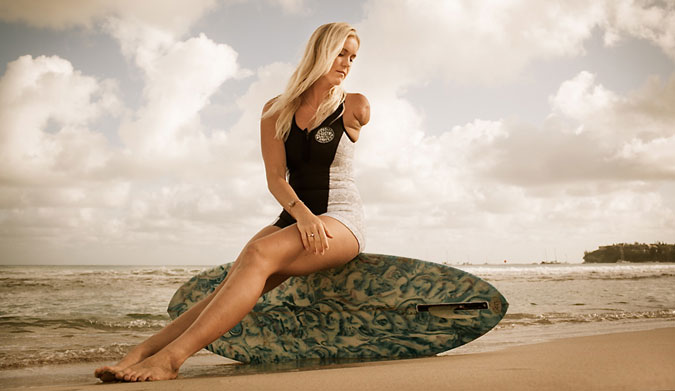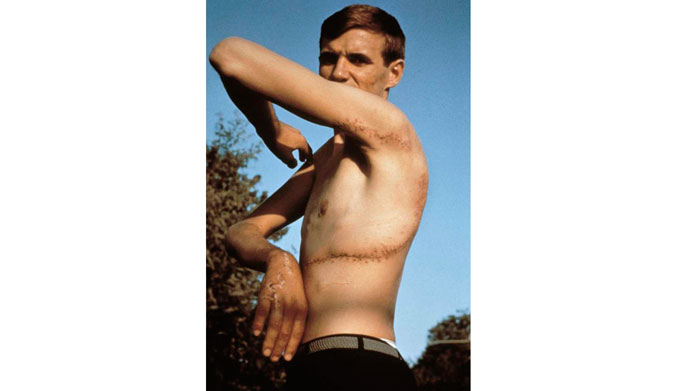
Rodney Fox, Mick Fanning, and Bethany Hamilton. Different eras, all survivors. Photos, from L to R: Alamy/WSL/Kirstin Scholtz/Mike Coots
Shark attacks are, perhaps, the scariest thing that can happen to one while in the ocean. In the last few years, they’ve been in the news more than ever, and the debate rages on about whether that’s because of more shark attacks or simply more reporting on shark attacks.
Either way, it seems obvious (to me, at least) that killing them all is definitely not the answer. Here’s some actual math behind that statement, for those who care to read it. And while I understand that some feel that things like the list below only add fuel to a fire that’s burning far too brightly, the simple fact is that shark attacks happen, they’re fucking terrifying, and–God love the internet– people want to read about them. So here are six of the most (in)famous shark attacks in history.
1. Mick Fanning, J-Bay, South Africa:
The entire world heard about Mick Fanning’s shark attack. During the finals of the J-Bay event, which was being broadcast live to the whole world, a lively great white with absolutely no idea of the shit-storm he was about to create decided to have a quick look at the three time world champ. Mick, of course, acted like a total fucking badass and beat the shit out of it, while Julian Wilson paddled his ass off TOWARDS the shark, and a lone photographer was left floating around in the lineup with the shark.
The internet quickly exploded. CNN interviewed Fanning. Julian was hailed as a hero. Fights broke out about whether it was an “attack” or an “encounter.” It was definitely an attack, by the way… at least technically. Memes infested the internet, and at least one person at the World Surf League silently celebrated, because honestly, there will never be a better story than that.

Bethany Hamilton: the strongest surfer there is. Photo: Mike Coots
2. Bethany Hamilton, Kauai, Hawaii:
Bethany Hamilton has inspired millions of people. Hers is a comeback story for the ages. Back in 2003, when she was 13, she paddled out on Halloween at Tunnels Beach, Kauai with Alana, Holt, and Byron Blanchard. At just after 7 in the morning, she was attacked by a 14 foot tiger shark. After the Blanchards got her to shore, Alana’s father tied a tourniquet above Bethany’s severed left arm with a leash, then rushed her to the hospital, where she hovered on the edge of death.
Her recovery was nothing short of miraculous. Within three weeks, she was back in the water. “I started surfing less than a month later,” she told WhatCulture. “It happened in October, and my first competition was in January so it was pretty quick. I just surfed a lot and worked hard at it, and figured it out. I guess it probably took a good year to really feel totally natural about it.”
Then, just two years later, in 2005, she won the NSSA, becoming the National Champion… with one arm. Bethany, along with a very select few other surfers, have broken the barrier between famous surfer and straight up superstar. In 2004, her autobiography became a bestseller, and in 2011, it was made into a movie, Soul Surfer. And through it all, she’s continued charging harder than ever. So hard, in fact, that she took home first place in the 2014 Surf n Sea Pipeline Pro.

Rodney Fox, a few months after his attack in Australia. Photo: Alamy
3. Rodney Fox, Aldinga Beach, Australia:
You may not have heard of Rodney Fox, but only because his attack happened well before the internet came into existence. In 1963, Rodney Fox was thought of as one of the best spearfishermen in the world. That same year, during the Australian Spearfishing Championships just south of Adelaide, Fox went through one of the worst shark attacks in history.
A great white bit him around the waist, puncturing his diaphragm, ripping his lungs, crushing his rib cage, and leaving many of his organs so exposed that when he was finally brought back to the beach, rescuers were forced to keep his wetsuit on to keep his insides… well, inside.
“[It] broke every rib in my left-hand chest,” he recounted to McSweeny’s. “It broke the main artery from the heart. The stomach was left exposed. The spleen was left exposed. The lung had twenty-nine stitches in it. I had all my tendons in my right hand cut.”
But it didn’t end after than initial bite. Before he was saved, the shark came back a second time, clamping onto his arm and dragging him down to the bottom. Fox was able to gouge the shark’s eyes, forcing it to release him.
Depending on what you read, Fox required four hours of surgery and around 400 stitches to make him whole again. Since then, however–and this seems to be the case with many shark attack survivors–he’s become something of a shark activist. He designed the first underwater shark observation cage, and has become an authority on great whites. “We had over 250 people that drowned last year,” he said. “We had three deaths by sharks only. People don’t say, ‘Oh, don’t go to Australia and get drowned.’ They say, ‘Go to Australia and watch out for the sharks.'”
Less than a year after his attack, Fox was at the Zoo when he came up with the idea for the shark cage. With it, he filmed some of the first underwater footage of great whites. After that footage ended up on the desk of Steven Spielberg, the director enlisted his help to work on the movie Jaws.
“I didn’t tell people I worked on Jaws for a while because I didn’t want to frighten them; I wanted them to come and see the sharks,” he told the International Business Times.
4. John Braxton, Big Island, Hawaii:
Without Instagram, John Braxton would likely just be another statistic. Because of it, he turned into a bonafide overnight sensation, albeit for a pretty awful reason. When the 27-year-old went spearfishing off Big Island’s Upolu Point, a 13-foot tiger shark bit a massive chunk out of his leg.
After escaping the shark, Braxton swam to shore, where his partner tied a tourniquet and called 911. When the ambulance arrived, Braxton, in act that baffled nearly everyone, pulled out his phone and proceeded to video himself talking about it before panning down to a leg that looked like ground beef.
The video was removed from Instagram, but not before it found its way to Youtube, where the entire computer-having population of the world gagged while watching it.

Elio Canestri was one of the most promising young surfers. Photo: jeremy Flores/Instagram
5. Elio Canestri, Cap Homard, Reunion Island:
Elio’s story is incredibly sad. A promising 13-year-old French surfer, Canestri’s life was cut tragically short when an 8-foot bull shark attacked and killed him 50 yards from shore. Despite the ban on surfing in Reunion, Elio, along with a group of friends and his surf coach, paddled out.
The attack occurred just feet from his surfing partners, and sparked a cry of outrage from Reunion residents. Sick of the attacks–Reunion has one of the highest shark attack rates per capita on earth–they rallied in front of government building calling for more stringent action. Two years before Canestri’s death, in 2013, Reunion banned surfing, swimming, and body surfing, and came up with a culling plan that included 45 bulls and 45 tigers. Surfers were to be fined if they entered the water.
It was a complicated issue, though, and many were against the cull, putting the government in a tough position. In 2007, Reunion was turned into a marine reserve in an effort to protect the surrounding coral reefs and encourage tourism. Fishing was banned, a fact which many thought was responsible for the rise in sharks and shark attacks.

Front page news of the spate of shark attacks on the Jersey Shore, 1916.
6. The Jersey Shore, 1916:
This one isn’t just one person. In the summer of 1916, five shark attacks occurred in ten days, resulting in four deaths. In the first two weeks of July, a heat wave of epic proportions blanketed the eastern seaboard, sending thousands to the coast. Up until then, shark attacks were relatively rare outside of Florida, and many researchers believe the massive influx of tourists in the ocean played a role in the attacks. Often thought to be an inspiration for the movie Jaws, the Jersey Shore shark attacks have gained a certain notoriety aptly named the Real New Jersey Jaws.
The first attack happened when a man named Charles Vansant was taking a swim at dusk when he was killed. Then, less than a week later, Charles Bruder fell victim to another attack, which took his life as well. The last of the three in the spate of violence happened just north of the first two, claiming the lives of two more and leaving a third in critical condition. It’s still not clear what kind of shark was responsible, but most scientists believe it was either a great white or a bull shark.
In the months following the deaths, the entire nation panicked. At the time, not much was known about shark attacks, and the two week terrifying ordeal became one of the forerunners of the hysteria surrounding sharks we see today. Since then, Nat Geo, the History Channel, and the Discovery Channel have all aired documentaries about it.

